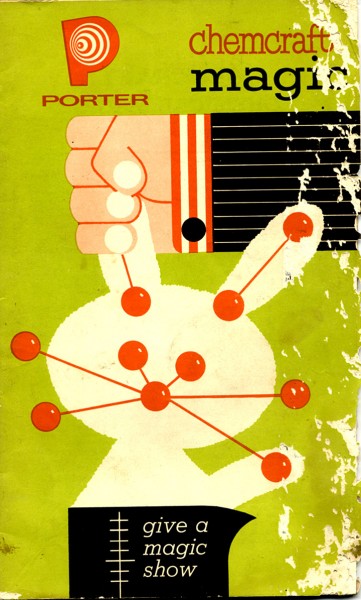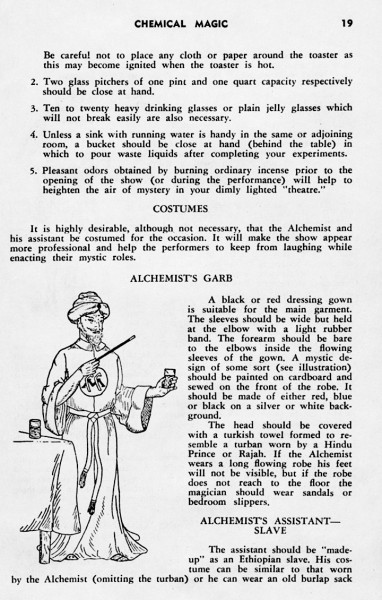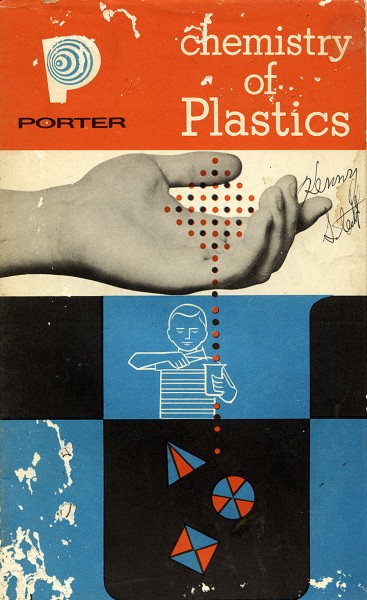 Sometime after Lincoln Logs and before cameras came my science phase. Dad and Mother gave me increasingly larger and more complex chemistry sets, including one that contained radioactive materials. I also had a couple of microscopes, ranging from not too good to pretty decent.
Sometime after Lincoln Logs and before cameras came my science phase. Dad and Mother gave me increasingly larger and more complex chemistry sets, including one that contained radioactive materials. I also had a couple of microscopes, ranging from not too good to pretty decent.
This must have been a supplemental manual for one of the earlier sets. It was aimed at preparing the budding chemist to be able to wow his (the chemistry sets were aimed at boys) family and friends.
Exciting and mystifying experiments
Experiment 35 – A chemical smoke screen: Put 3 or 4 measures of Amonium Chloride (No. 9) on a spoon and heat it over a flame. In a few moments it will begin to give off thick clouds of smoke which will continue until the substance is entirely volatilized. [If you REALLY want to see something volatile and smoking, wait until your mother sees what you did to her spoon.]
Experiment 56 – How to make a disagreeable odor: Place 4 measures of Sulfur (#1) in a test tube and add a piece of candle about 1/8 inch long. Heat the test tube over a flame, and after a minute notice the disagreeable odor of the evolved gas. The gas is hydrogen sulfide, which has an odor resembling that encountered when a rotten egg is broken. [It also reminds me of the gym showers after PE.]
Experiment 67 – Changing a dime to a penny: Dissolve 2 measures of Azurite (No. 39) and 5 measures of Sodium Bisulfate (No. 7) in a test tube half full of water. Pour this into a clean glass and place a bright silver coin and a small piece of iron in the solution. (A small nail will work very well.) Be sure the iron touches the coin. In a few moments, the coin will be covered with a red coating of copper. By means of this experiment, you can easily change your friends’ dimes into pennies. [Of course, we changed copper coins into “silver” ones by applying mercury to the coins in the chem lab, something that would bring guys in moon suits running these days.]
I didn’t have a turban
 I managed to do the experiments, but couldn’t come up with a turban or an “Ethiopian slave” to be my alchemist’s assistant, hence I didn’t give any public performances. The Chemcraft people knew that any boy who was fooling around with a chemistry set wouldn’t have a shot at attracting a pretty girl as an assistant, so that subject wasn’t even broached.
I managed to do the experiments, but couldn’t come up with a turban or an “Ethiopian slave” to be my alchemist’s assistant, hence I didn’t give any public performances. The Chemcraft people knew that any boy who was fooling around with a chemistry set wouldn’t have a shot at attracting a pretty girl as an assistant, so that subject wasn’t even broached.
Plastics
 Here is a snippet from one of my favorite movies:
Here is a snippet from one of my favorite movies:
Mr. McGuire: I just want to say one word to you. Just one word.
Benjamin: Yes, sir.
Mr. McGuire: Are you listening?
Benjamin: Yes, I am.
Mr. McGuire: Plastics.
Yep, it’s from the 1967 movie The Graduate, starring Dustin Hoffman, Anne Bancroft and Katharine Ross. It’s fascinating to read how many different actors were considered before the directors settled on those three. It also makes me feel old when I read that Ross was born in 1940 and will be 74 on January 29.
The Future is Plastics
The Chemcraft manual, copyright 1957, like Mr. McGuire, predicted a bright future for plastics.
“The most extensive use of plastics ever undertaken in railway car construction was shown to railroad men recently (looks like they didn’t make railroad women in those days). Plastic was combined with fibrous glass to mold the 44 double seats, luggage compartment, baggage racks, car steps, ceiling and interior side panels, end doors, exterior bottom trim, battery boxes and washroom unit, including toilet, sink, radiator grill and wall. The use of plastics in this car results in the lightest weight per passenger of any railway passenger car ever built, yet meets all the strength and safety requirements of the Association of American Railroads.
“…The day is not too far distant when planes will fly on plastic wings.”
Did you hear that Benjamin?
Speaking of Benjamins, I saw a website where a reproduction of the Magic manual was going for $15.
